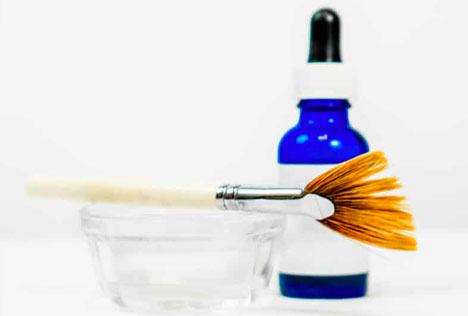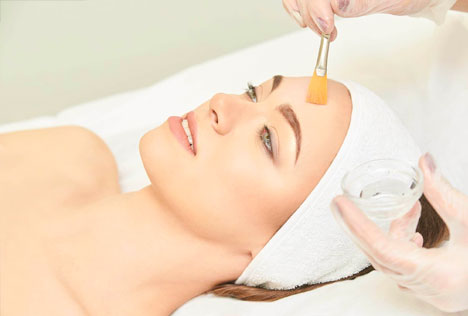Chemical Peel

Your skin is the largest organ of your body. How it looks defines your beauty and how you think of yourself. The wrinkles around your eyes may remind you of your age, while small scars can make you relive past mistakes. As you age, your skin reveals more and more about you.
Some skin changes are temporary, like bruises and acne, but they can affect your self-esteem. Other changes may reflect serious health concerns, such as basal cell carcinoma or melanoma. Ask your NYC dermatologist about any changes in your skin; if it’s cosmetic, a chemical peel may provide an answer. If it’s medical, you want a dermatologist and not a cosmetician to make that call.
The Benefits of Chemical Peels
Before your chemical peel, a top Manhattan dermatologist examines you and talks about your skincare issues. For anything beyond cosmetic concerns, your dermatology NYC doctor offers further diagnostic and treatment options. At the same time, you can discuss which chemical peel is right for you. Chemical peels vary in strength. You can get one to exfoliate just the top layer of skin, or you can have one that reaches deeper.
Don’t let the words “chemical” or “acid” worry you; the solutions used in peels are safe synthetic versions of acids found in fruits and vegetables. They’ve been used for many years with great success. Chemical peels can treat:
- Dry or rough skin;
- Acne;
- Scarring, including acne scars;
- Age spots;
- Hyperpigmentation;
- Freckles;
- Fine lines and wrinkles;
- Melasma;
- Some pre-cancerous spots.
Superficial Peel
 Also known as the lunchtime peel, this type of chemical peel is perfect if you just need to remove the top layer of skin to brighten up your appearance and correct mild discoloration. The process takes roughly half an hour. It’s commonly used on faces, chests, and hands.
Also known as the lunchtime peel, this type of chemical peel is perfect if you just need to remove the top layer of skin to brighten up your appearance and correct mild discoloration. The process takes roughly half an hour. It’s commonly used on faces, chests, and hands.
With superficial chemical peels, your New York dermatologist applies a mild solution to your targeted skin. The salicylic or alpha-hydroxy acid penetrates only the outer layer of skin, exfoliating it and leaving behind a fresh, more youthful appearance. Superficial peels can take up to a week to heal, so expect some peeling, flaking, redness, and minor stinging. These peels aren’t painful, and you can wear makeup as soon as the day after your peel.
Medium Peel
Medium chemical peels use a stronger acid solution than superficial peels, reaching deeper into your skin’s layers. Think about a book whose first few pages have been created or splashed with coffee. The creases and discoloration don’t penetrate the full thickness of the book, and the pages beyond those first few still look new. Like that, a medium peel lifts away those first layers to remove or reduce fine lines, rough patches, freckles, melasma, minor scarring, and even some pre-cancerous areas.
Recovery from a medium chemical peel can take up to two weeks. During the first couple of days, your skin is likely to be red and swollen, and you may need to take time off work. Blisters may develop, and your skin peels away in about a week. The skin layer below may be sensitive for a week or more, but you can wear makeup after the affected layers have peeled away.
Deep Peel
As the name suggests, a deep chemical peel penetrates the outer and medium layers of skin more deeply than other chemical peels. This peel uses the strongest acid solution to remove or reduce deeper wrinkles, acne, scars, freckles, and skin discoloration. This type of peel is usually reserved for your face.
Because of its strength, a deep chemical peel is more painful than a superficial or medium peel. Your recovery may take up to three weeks. Expect redness, swelling, stinging, and blistering as the affected skin peels away and your face continues to heal. Your face is bandaged following a deep peel, and your NYC dermatologist monitors you in the weeks following the procedure to ensure proper healing.
Follow-up Care
Your procedure is done right in your dermatologist’s office. It may take up to two hours, although for part of that time, you’re reviewing important follow-up instructions, such as:
- Stay out of the sun completely while you heal from a deep chemical peel;
- Schedule a follow-up appointment for your medium or deep chemical peel;
- Protect your skin with sunscreen after any peel.
Naturally, the deeper the peel, the more involved the recovery process. You may need pain relief, including topical creams or lotions that you apply to ease the stinging and redness from a deeper peel. Following a medium or deep chemical peel, you may need prescription-strength anti-viral medication to reduce the risk of infection. Your dermatologist will instruct you to care for your skin by soaking the affected areas, applying any necessary creams, and changing the bandages. If you have concerns during your recovery, call your NYC dermatologist’s office.
Risks and Side Effects
There are few risks associated with chemical peels, though rare, they can include:
- Scarring;
- Temporary swelling, peeling, and flaking;
- Permanent skin discoloration;
- Reactivation of cold sores;
- Mild to moderate stinging pain.
Most people can benefit from a peel. But you shouldn’t have a chemical peel if you:
- Are pregnant or suspect you might be;
- Are currently nursing;
- Have a history of skin disorders;
- Have had cold sores, including herpes simplex virus, type 1;
- Use certain medications, herbal remedies, or topical creams;
- Use prescription acne medications, such as Accutane;
- Have a sunburn or any open cuts or sores;
- Had a bad experience with chemical peels before.
If a chemical peel isn’t right for you, your Manhattan dermatologist can work with you to find an alternative treatment to address your skincare concerns. Contact us to look and feel your very best and to make sure your skincare needs are met safely and completely.
Important Reminder: This information is only intended to provide guidance, not definitive medical advice. Please consult dermatologist NYC about your specific condition. Only a trained, experienced board-certified dermatology doctor or pediatric dermatologist could determine an accurate diagnosis and proper treatment.
Locations: Manhattan Dermatology (Upper East Side) 983 Park Ave, Ste 1D1, NY 10028(212) 427-8750 Manhattan Dermatology (Midtown) 56 W 45th St, Ste 819, NY 10036
(212) 889-2402 Manhattan Dermatology (Union Square) 55 W 17th St, Ste 103, NY 10011
(212) 378-9984

